Tourist route and zones
NAKHCHIVAN – GAMIGAYA TOURIST ROUTE
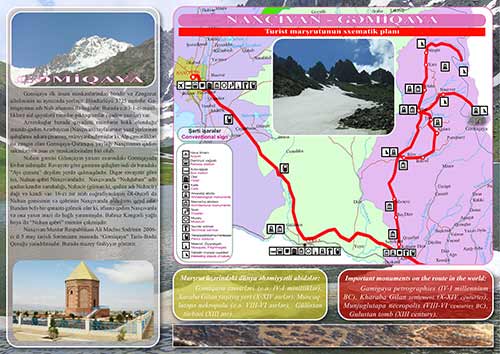 |
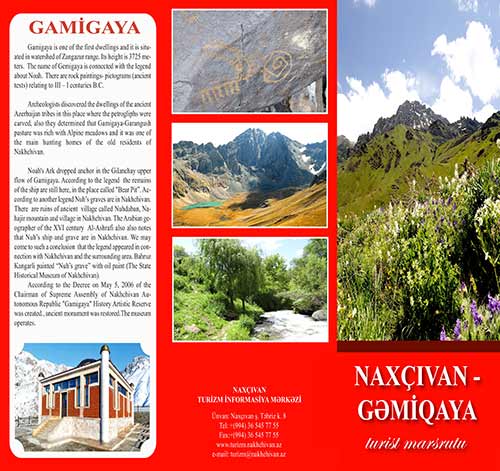 |
Gamigaya is one of the earliest human settlements and is located in the watershed of the Zangazur chain. The height of it is 3725m. The name of Gamigaya is linked with the legend of Noah. There are pictograms of the 3-1 millenniums B.C. here. Archaeologists discovered the ancient dwelling houses of the Azerbaijani turks’ forefathers in the Garangush summer pasture where the pictographies were engraved on the rocks and proved that the Alp meadow rich Garangush summer pasture was the place of hunting of the ancient Nakhchivan people.
According to the widespread legend in Nakhchivan, Prophet Noah's Ark dropped anchor in the upper course of the river Gilyanchay, in Gamigaya. The legend says that the remains of the ship are still here, in a place called "Ayi Chukhuru" ("Bear pit"). According to another legend, the grave of Prophet Noah is in Nakhchivan. There are the remains of the village "Nuhdaban" related to ancient times, and the village and the mountain called Nahadzhir (formerly as considered "Nuhadzhir") in Nakhchivan. Consequently, we can conclude that the ancient legend is connected with Nakhchivan and its surroundings. Behruz Kengerli painted the tomb of Noah with oil paint.
In accordance with Decree of Chairman of the Supreme Assembly of the Nakhchivan Autonomous Republic on May 5, 2006, «Gamigaya» historical-artistic nature reserve was established. Currently a museum operates here.
NAKHCHIVAN – ALINJAGALA TOURIST ROUTE
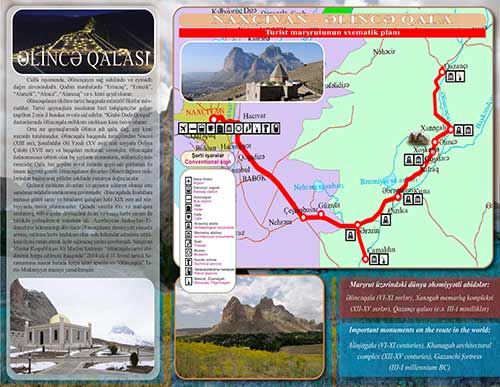 |
 |
Fortress is on the top of the mountain of the same name, on the right bank of Alinjachay, Julfa region. In the oldest sources it is written as - "Erinjag", "Erinjik", "Alanjik", "Alinja", "Alanjug", and etc.
There are different opinions about the construction date of the castle. Some historians think that it is 2 thousand-year castle. Alinja is depicted as strong fortress in "Kitabi-Dada Gorgud" epos as well.
Alinja name is considered as the name of the tower, mountain, river in medieval sources. There is sufficient information about the castle in the works of many historians, namely Nasavi (XIII c.), Sharafaddin Ali Yazdi (XV c.), turkish traveler Evliya Chalabi (XVII c.), and others. Alinjagala is a symbol of grandeur and bellicosity of this land having unique nature. The castle, first of all, astonishes people with its extraordinary appearance. Castle walls starting from the feet of Alinja mountain rise upwards as steps.
The remainders of the beautiful palaces and buildings belonging to the feudals in the Alinjagala were depicted in the literature of the XIX century. It was possible to keep a herd of horses and cattles before and other military ammunition in the fortress. In the rein of the Azerbaijan Atabaylar –the Eldanizlar power, the importance of the Alinjagala rose and turned the place of shelter, for the security of the rulers’ families, which was considered the most strategic military fortification.
In accordance with the Decree of the Chairman of the Supreme Assembly of Nakhchivan Autonomous Republic on February 11, 2014, "On the restoration of historical monument Alinjagala" here are conducted restoration works and created a historical and cultural museum-reserve "Alinjagala".
NAKHCHIVAN – ASHABI-KAHF TOURIST ROUTE
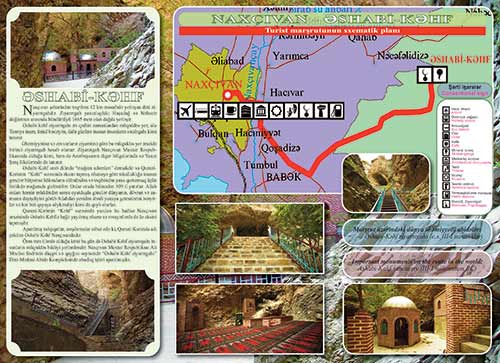 |
 |
A sanctuary in the natural cave, between Hachadagh and Nahajir mountains, at 12 km distance from Nakhchivan city, on the height of 1665m.
Since ancient times Ashabi-Kahf is considered as a sacred place, a kind of altar of faith in the Great God.
This sacred place is considered as the most important sanctuary for pilgrims and importance. Sanctuary is known in Nakhchivan Autonomous Republic, as well as in other regions of Azerbaijan and countries of the Middle East.
Ashabi-Kahf means "Cave masters" in arabic. According to the 18 surah (aya) of the chapter "al-Kahf" in Korani-Kerim, it is about those persons who had stood against those who trusted in others, besides God, and as a result of which they had left them and hid themselves in that cave. They were 7 youth (Tamlikha, Barnush, Sarnush, Maksilma, Maslina, Sazanush, Kaftantush (shepherd), and their devoted dog Gitmir). It is about their sleeping over 309 years and the events they face with thereafter.
The event existing in Korani-Kerim can also be seen in legends about Ashabi-Kahf in.
Researches show that Ashabi-Kahf noted in Koran is in Nakhchivan.
As in the previous millennia, today people consider this place as a sacred place of worship. Thanks to the attention and care of the Chairman of Sumpreme Assembly, renovation work was carried out here.
NAKHCHIVAN – ORDUBAD TOURIST ROUTE
 |
 |
Historical monuments: The Jame Mosque, the Dilbar-Mosque, the Afgan Tower, the Geysariya indoor trade complex with round domes (XVII century), an ice-house (XVIII century), mosques , two-storied madrasah, and etc.Ordubad is the second largest town in Nakhchivan Autonomous Republic. According to some sources, the town was founded in V-VI centuries. It is located 850m above sea level. For its ancient history, the large number of historical monuments, almost untouched exterior by new buildings, and preserved domestic life of its residents, the town has been named as the state historical-architectural reserve.
The town houses the Museum of Regional History with splendid collections, a folk theatre, the memorial museum of M.S.Ordubadi, a writer and the founder of the historical-romantic genre in Azerbaijani literature, the house-museum of an academician Yusuf Mammadaliev and prominent educationist Mohammad Taghi Sidgi.
There are many houses for accepting tourists in Ordubad.
NAKHCHIVAN – GARABAGHLAR TOURIST ROUTE
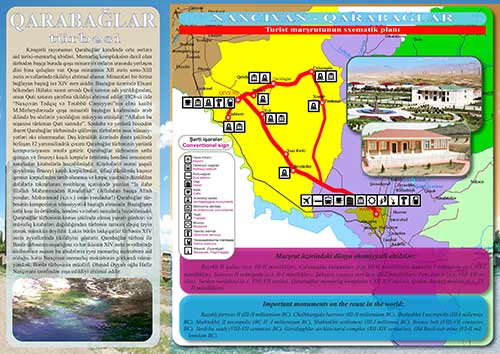 |
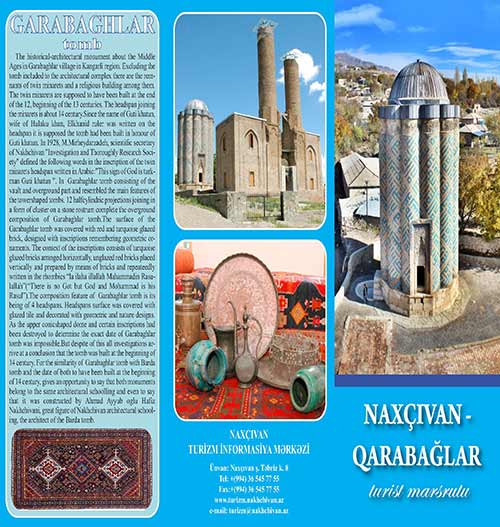 |
The historical-architectural monument belonging to the Middle Ages in Garabaghlar village in Kangarli region. Excluding the tomb included to the architectural complex there are the remnants of twin minarets and a religious building among them. The twin minarets are supposed to have been built at the end of the 12, beginning of the 13 centuries. The headspan joining the minarets is about 14 century. Since the name of Guti khatun, wife of Hulaku khan, Elkhanid ruler, was written on the headspan, it is supposed the tomb had been built in honour of Guti khatun. In 1928, M.Mirheydarzadeh, scientific secretary of Nakhchivan "Investigation and Thoroughly Research Society" defined the following words in the inscription of the twin minarets headspan written in Arabic: "This sign of God is turkman Guti khatun’s". In Garabaghlar tomb consisting of the vault and overground part, the main features of the towershaped tombs is reflected. 12 halfcylindric projections joining in a form of cluster on a stone rostrum complete the overground composition of Garabaghlar tomb.The surface of the Garabaghlar tomb was covered with red and turquoise glazed brick, designed with inscriptions remembering geometric ornaments. The context of the inscriptions consists of turquoise glazed bricks arranged horizontally, unglazed red bricks placed vertically and prepared by means of bricks and repeateedly written in the rhombics “la ilaha illallah Mahammadin Rasulallah”(“There is no God except him, and Mohammad is his Rasul”).The composition feature of Garabaghlar tomb is its being of 4 headspans. Headspans surface was covered with glazed tile and decorated with geometric and nature designs. As the upper conicshaped dome and certain inscriptions had been destroyed to determine the exact date of Garabaghlar tomb was impossible.But despite of this, all investigations arrive at a conclusion that the tomb was built at the beginning of XIV century.
For the similarity of Garabaghlar tomb with Barda tomb and the date of both to have been built at the beginning of XIV century, gives an opportunity to say that both monuments belong to the same architectural schoolling and even to say that it was constructed by Ahmad Ayyub oglu Hafiz Nakhchivani, great figure of Nakhchivan architectural schooling, the architect of the Barda tomb.

